Mechanical and Thermal Properties of Polylactide (PLA) Composites Modified with Mg, Fe, and Polyethylene (PE) Additives
Abstract
1. Introduction
2. Materials and Methods
2.1. Samples Preparation
2.2. Weight Loss Test
2.3. Differential Scanning Calorimetry and Degree of Crystallinity
2.4. Thermogravimetry and Activation Energy
2.5. Hardness, Tensile Tests and SEM Observations
2.6. Physicochemical Properties of Contact Solution
3. Results and Discussion
4. Conclusions
Author Contributions
Funding
Conflicts of Interest
References
- Jalbrzykowski, M. Selected Issues of the Injection Process of Biopolymers for Technical Applications, on the Example of Polylactide Acid; PTIR: Cracow, Poland, 2019.
- Liang, H.; Hao, Y.P.; Liu, S.R.; Zhang, H.L.; Li, Y.S.; Dong, L.S.; Zhang, H.X. Thermal, rheological, and mechanical properties of polylactide/poly (diethylene glycol adipate). Polym. Bull. 2013, 70, 3487–3500. [Google Scholar] [CrossRef]
- Piemonte, V.; Gironi, F. Kinetics of Hydrolytic Degradation of PLA. J. Environ. Polym. Degrad. 2013, 21, 313–318. [Google Scholar] [CrossRef]
- Luckachan, G.E.; Pillai, C.K.S. Biodegradable polymers-a review on recent trends and emerging perspectives. J. Polym. Environ. 2011, 19, 637–676. [Google Scholar] [CrossRef]
- Malinowski, R.; Rytlewski, P.; Żenkiewicz, M. Effects of electron radiation on properties of PLA. Arch. Mater. Sci. Eng. 2011, 49, 25–32. [Google Scholar]
- Norazlina, H.; Kamal, Y. Graphene modifications in polylactic acid nanocomposites: A review. Polym. Bull 2015, 72, 931–961. [Google Scholar] [CrossRef]
- Żenkiewicz, M.; Rytlewski, P.; Malinowski, R. Compositional, physical and chemical modification of polylactide. J. Achiev. Mater. Manuf. Eng. 2010, 43, 192–199. [Google Scholar]
- Liber-Kneć, A.; Łagan, S. Application of the measurement of the contact angle and the surface free energy to characterize the surfaces of polymers used in medicine. Polym. Med. 2014, 44, 29–37. [Google Scholar]
- Łysik, D.; Mystkowska, J.; Markiewicz, G.; Deptula, P.; Bucki, R. The influence of mucin-based artificial saliva on properties of polycaprolactone and polylactide. Polymers 2019, 11, 1880. [Google Scholar] [CrossRef]
- Domb, A.J.; Kumar, N. Biodegradable Polymers in Clinical Use and Clinical Development; John Wiley & Sons: Hoboken, Germany, 2011; ISBN 978-0-470-42475-9. [Google Scholar]
- Wootthikanokkhan, J.; Cheachun, T.; Sombatsompop, N.; Thumsorn, S.; Kaabbuathong, N.; Wongta, N.; Wong-On, J.; Isarankura Na Ayutthaya, S.; Kositchaiyong, A. Crystallization and Thermomechanical Properties of PLA Composites: Effects of Additive Types and Heat Treatment. J. Appl. Polym. Sci. 2013. [Google Scholar] [CrossRef]
- Renouf-Glauser, A.C.; Rose, J.; Farrar, D.F.; Cameron, R.E. The effect of crystallinity on the deformation mechanism and bulk mechanical properties of PLLA. Biomaterials 2014, 29, 5771–5782. [Google Scholar] [CrossRef]
- Muhammad Sami, H. Phosphate Glass Fibre Reinforced Composite for Bone Repair Applications: Investigation of Interfacial Integrity Improvements via Chemical Treatments. Ph.D. Thesis, The University of Nottingham, Nottingham, UK, 1 August 2012. [Google Scholar]
- Jia, S.; Yu, D.; Zhu, Y.; Wang, Z.; Chen, L.; Fu, L. Morphology, crystallization and thermal behaviors of PLA-based composites: Wonderful effects of hybrid GO/PEG via dynamic impregnating. Polymers 2017, 9, 528. [Google Scholar] [CrossRef] [PubMed]
- Cifuentes, S.C.; Frutos, E.; Benavente, R.; Lorenzo, V.; González-Carrasco, J.L. Assessment of mechanical behavior of PLA composites reinforced with Mg micro-particles through depth-sensing indentations analysis. J. Mech. Behav. Biomed. Mater 2017, 65, 781–790. [Google Scholar] [CrossRef] [PubMed]
- Cifuentes, S.C.; Gavilán, R.; Lieblich, M.; Benavente, R.; González-Carrasco, J.L. In vitro degradation of biodegradable polylactic acid/magnesium composites: Relevance of Mg particle shape. Acta Biomater. 2016, 32, 348–357. [Google Scholar] [CrossRef] [PubMed]
- Jiang, D.; Ning, F. Fused Filament Fabrication of Biodegradable PLA/316L Composite Scaffolds: Effects of Metal Particle Content. Procedia Manuf. 2020, 48, 755–762. [Google Scholar] [CrossRef]
- Swain, S.K.; Gotman, I.; Unger, R.; Kirkpatrick, C.J.; Gutmanas, E.Y. Microstructure, mechanical characteristics and cell compatibility of β-tricalcium phosphate reinforced with biodegradable Fe–Mg metal phase. J. Mech. Behav. Biomed. Mater. 2016, 53, 434–444. [Google Scholar] [CrossRef]
- Tan, L.J.; Zhu, W.; Zhou, K. Recent Progress on Polymer Materials for Additive Manufacturing. Adv. Funct. Mater. 2020. [Google Scholar] [CrossRef]
- Ferri, J.M.; Motoc, D.L.; Bou, S.F.; Balart, R. Thermal expansivity and degradation properties of PLA/HA and PLA/TCP in vitro conditioned composites. J. Therm. Anal. Calorim. 2019, 138, 2691–2702. [Google Scholar] [CrossRef]
- Tsuji, H.; Sumida, K. Poly (L-lactide): V. Effects of storage in swelling solvents on physical properties and structure of poly (L-lactide). J. Appl. Polym. Sci. 2001, 79, 1582–1589. [Google Scholar] [CrossRef]
- De Jong, S.; Arias, E.R.; Rijkers, D.; Van Nostrum, C.; Kettenes-Van den Bosch, J.; Hennink, W. New insights into the hydrolytic degradation of poly (lactic acid): Participation of the alcohol terminus. Polymer 2001, 42, 2795–2802. [Google Scholar] [CrossRef]
- Iniguez-Franco, F.; Auras, R.; Burgess, G.; Holmes, D.; Fang, X.; Rubino, M.; Soto-Valdez, H. Concurrent solvent induced crystallization and hydrolytic degradation of PLA by water-ethanol solutions. Polymer 2016, 99, 315–323. [Google Scholar] [CrossRef]
- Tsuji, H. Hydrolytic degradation. In Poly (lactic Acid). Synthesis, Structures, Properties, Processing, and Applications; Auras, R.A., Lim, L.-T., Selke, S.E.M., Tsuji, H., Eds.; John Wiley & Sons: Hoboken, NJ, USA, 2010; pp. 345–381. [Google Scholar]
- Jalbrzykowski, M.; Krucinska, I.; Dabrowski, J. Tests of selected mechanical properties of PLA-PLA type composites. Compos Theory Pract. 2016, 2, 84–89. [Google Scholar]
- Djellali, S.; Haddaoui, N.; Sadoun, T.; Bergeret, A.; Grohens, Y. Structural, morphological and mechanical characteristics of polyethylene, poly (lactic acid) and poly (ethylene-co-glycidyl methacrylate) blends. Iran Polym. J. 2013, 22, 245–257. [Google Scholar] [CrossRef]
- Abay, A.K.; Gebeyehu, M.B.; Lin, H.K.; Lin, P.C.; Lee, J.-Y.; Wu, C.-M.; Murakami, R.-I.; Chiang, T.-C. Preparation and characterization of poly (lactic acid)/recycled polypropylene blends with and without the coupling agent, n-(6-aminohexyl) aminomethyl triethoxysilane. J. Polym. Res. 2016, 9, 198–204. [Google Scholar] [CrossRef]
- Nisar, M.; Bernd, M.; Filho, L.; Geshev, J.; Galland, G.B. Polypropylene/carbon nanotube magnetic composites obtained using carbon nanotubes from sawdust. Polym. Adv. Technol. 2019, 30, 457–464. [Google Scholar] [CrossRef]
- Zhu, J.; Uhl, F.M.; Morgan, A.B.; Wilkie, C.A. Studies on the mechanism by which the formation of nanocomposites enhances thermal stability. Chem Mater. 2001, 13, 4649–4654. [Google Scholar] [CrossRef]
- Visakh, P.M.; Yoshihiko, A. Thermal Degradation of Polymer Blends, Composites and Nanocomposites. Engineering Materials; Springer International Publishing: Cham, Switzerland, 2015. [Google Scholar]
- Zeng, R.; Qi, W.; Song, W.-Y.; He, Q.-K.; Cui, H.-Z.; Han, E.-H. In vitro degradation of MAO/PLA coating on Mg-1.21Li-1.12Ca-1.0Y alloy. Front. Mater. Sci. 2014, 8, 343–353. [Google Scholar] [CrossRef]
- Qin, L.; Qiu, J.; Liu, M.; Ding, S.; Shao, L.; Lü, S.; Zhang, G.; Zhao, Y.; Fu, X. Mechanical and thermal properties of poly(lactic acid) composites with rice straw fiber modified by poly(butyl acrylate). Chem. Eng. J. 2011, 166, 772–778. [Google Scholar] [CrossRef]
- Ndazi, B.S.; Karlsson, S. Characterization of hydrolytic degradation of polylactic acid/rice hulls composites in water at different temperatures. Express Polym. Let. 2011, 5, 119–131. [Google Scholar] [CrossRef]
- Gao, J.; Duan, L.; Yang, G.; Zhang, Q.; Yang, M.; Fu, Q. Manipulating poly (lactic acid) surface morphology by solvent-induced crystallization. Appl. Surf. Sci. 2012, 261, 528–535. [Google Scholar] [CrossRef]
- Wu, N.; Lang, S.; Zhang, H.; Ding, M.; Zhang, J. Solvent-induced crystallization behaviors of PLLA ultrathin films investigated by RAIR spectroscopy and AFM measurements. J. Phys. Chem. B 2014, 118, 12652–12659. [Google Scholar] [CrossRef]
- Elsawya, M.A.; Kimc, K.-H.; Parkc, J.-W.; Deep, A. Hydrolytic degradation of polylactic acid (PLA) and its composites. Renew. Sustain. Energy Rev. 2017, 79, 1346–1352. [Google Scholar] [CrossRef]
- Al-Itry, R.; Lamnawar, K.; Maazouz, A. Improvement of thermal stability, rheological and mechanical properties of PLA, PBAT and their blends by reactive extrusion with functionalized epoxy. Polym. Degrada. Stabil. 2012, 97, 1898–1914. [Google Scholar] [CrossRef]
- Hamad, K.; Kaseem, M.; Yang, H.W.; Deri, F.; Ko, Y.G. Properties and medical applications of polylactic acid. Express Polym. Lett. 2015, 9, 435–455. [Google Scholar] [CrossRef]
- Taranie, E.; Papageorgiou, G.Z.; Bikiaris, D.N.; Chrissafis, K. Kinetics of Crystallization and Thermal Degradation of an Isotactic Polypropylene Matrix Reinforced with Graphene/Glass-Fiber Filler. Molecules 2019, 21, 1984. [Google Scholar] [CrossRef]
- Krzan, A. Biodegradable Polymers and Plastics, “Innovative Value Chain Development for Sustainable Plastics in Central Europe”. PLASTiCE. 2013. Available online: https://keep.eu/projects/5559/ (accessed on 1 December 2020).
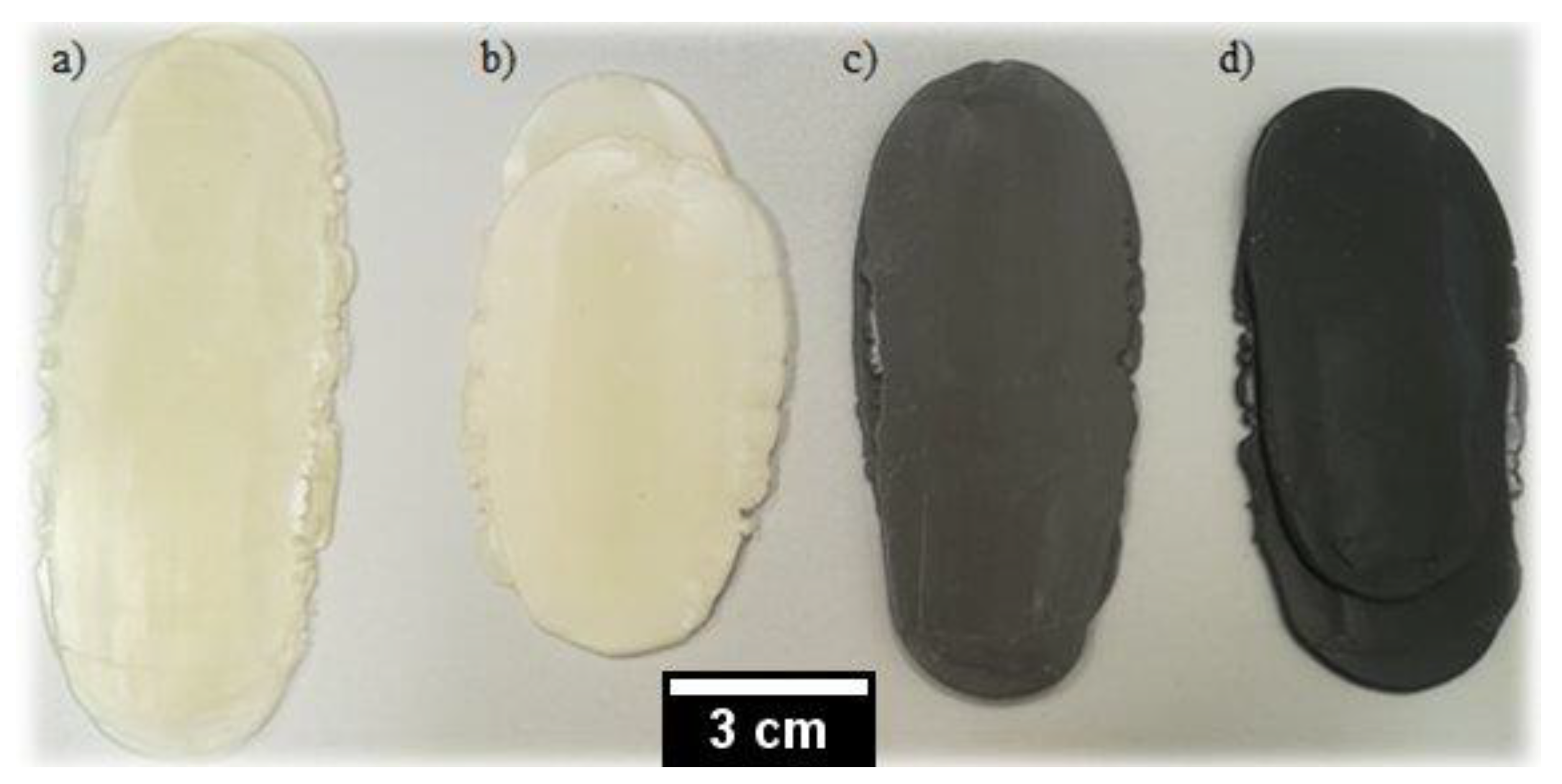
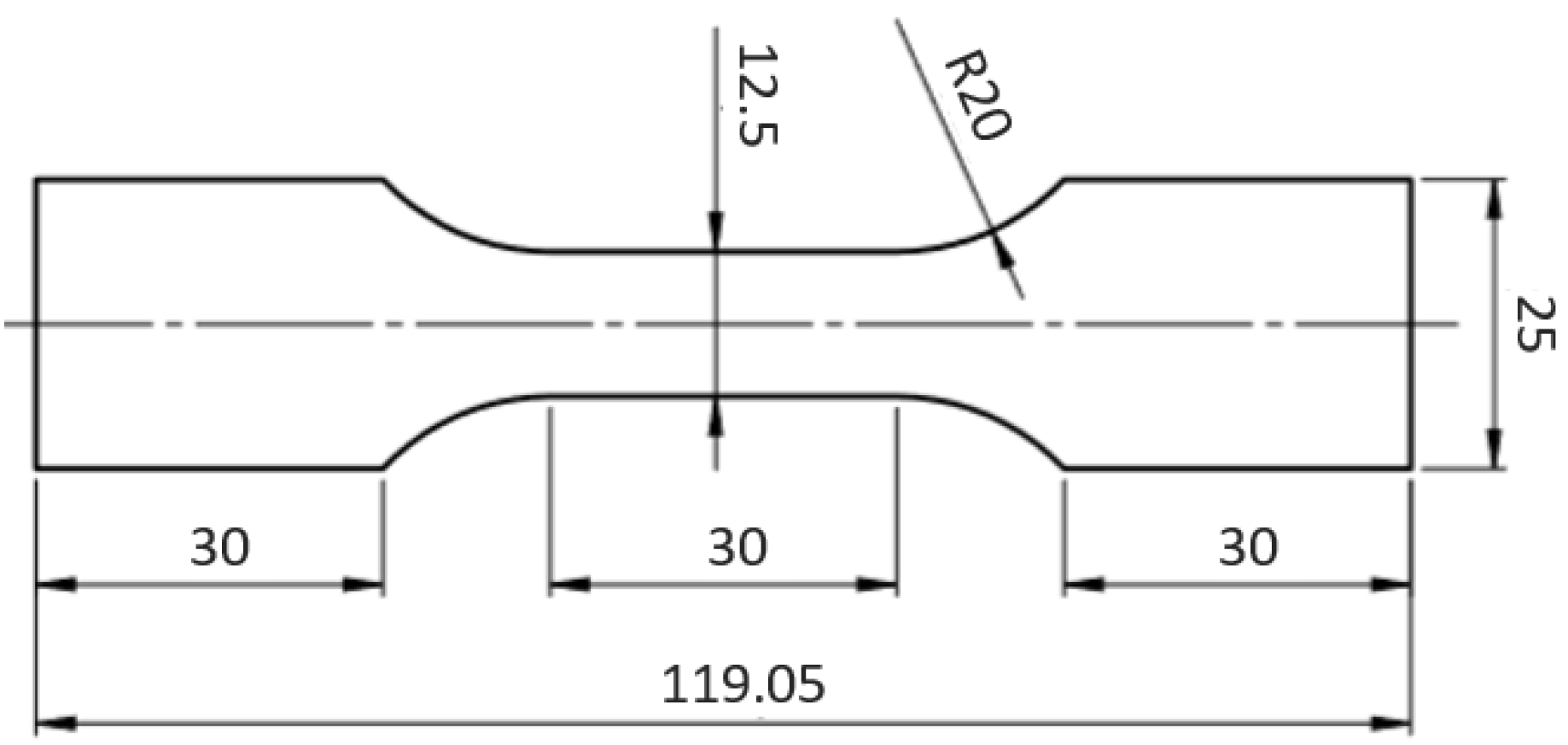

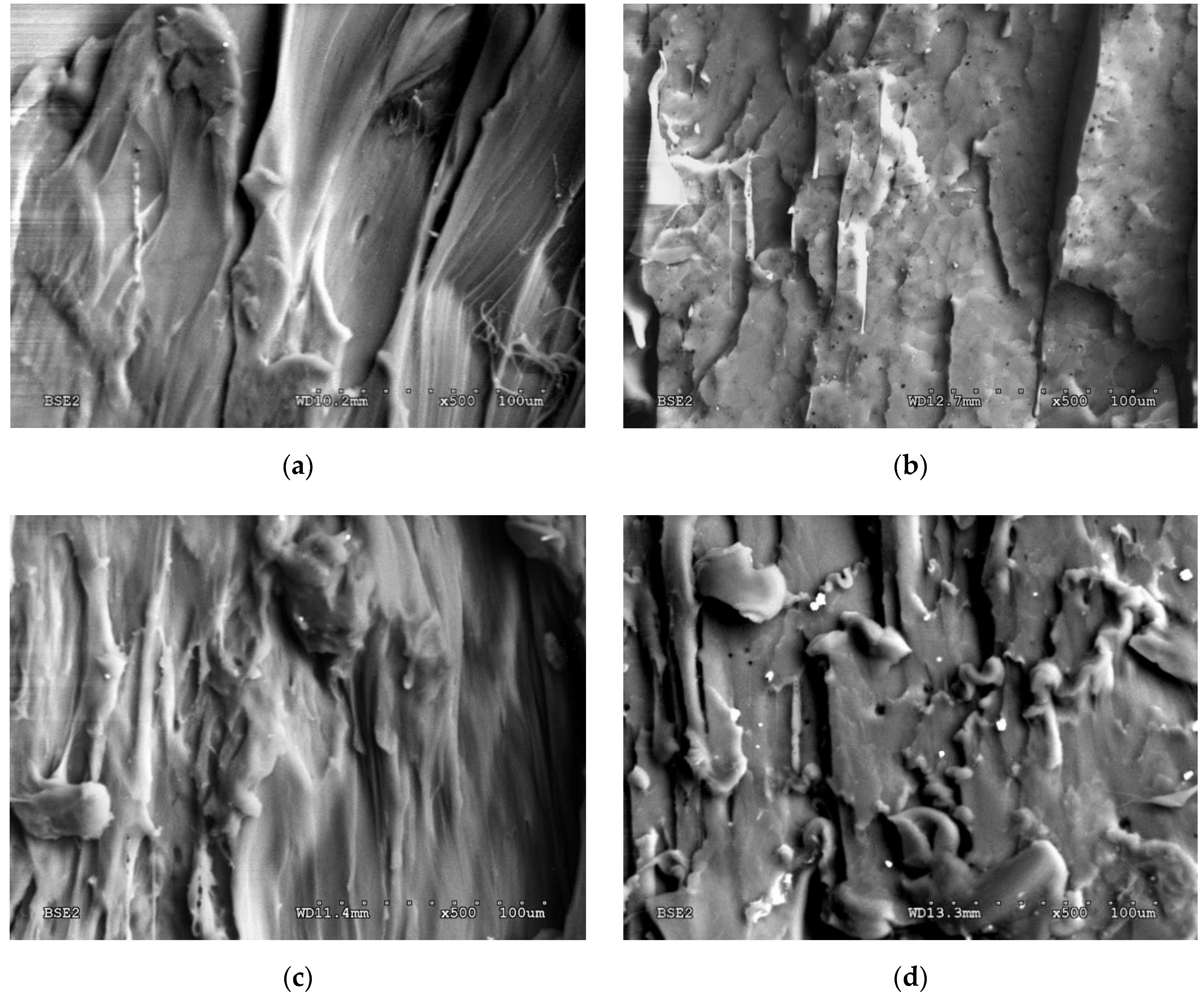
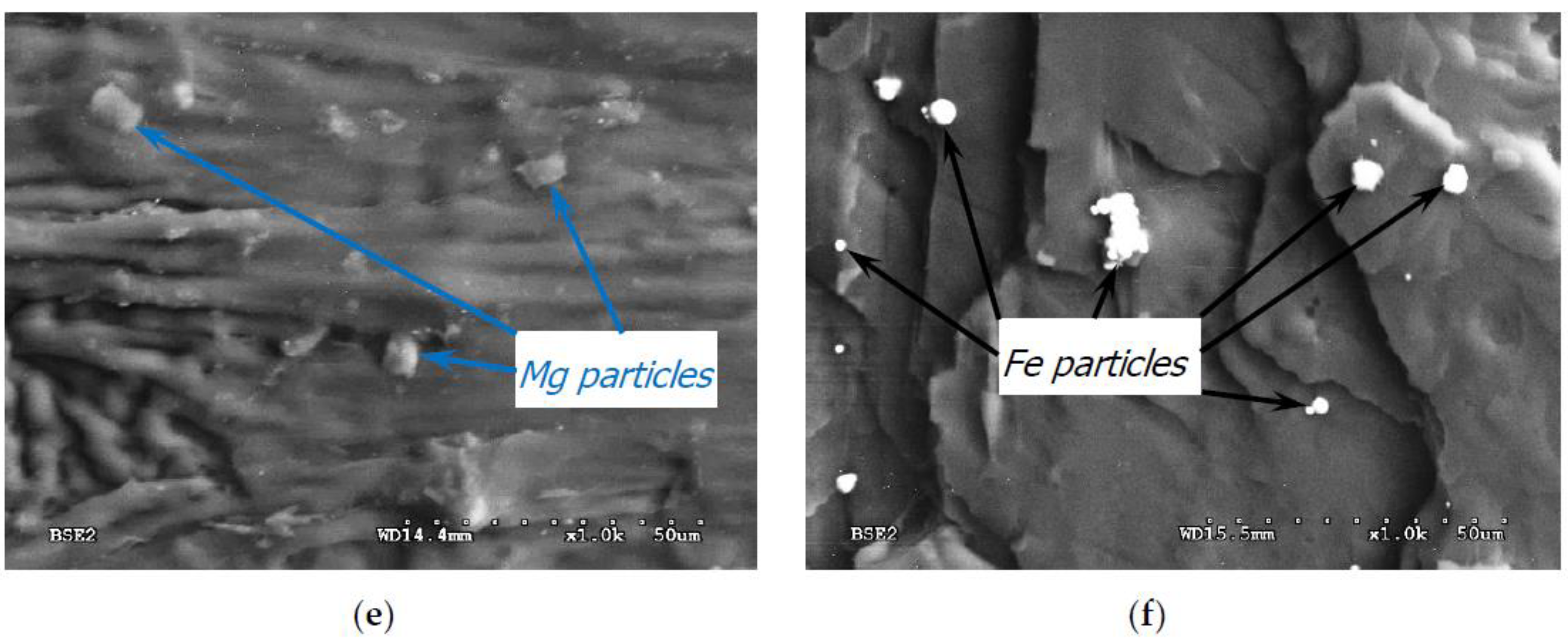
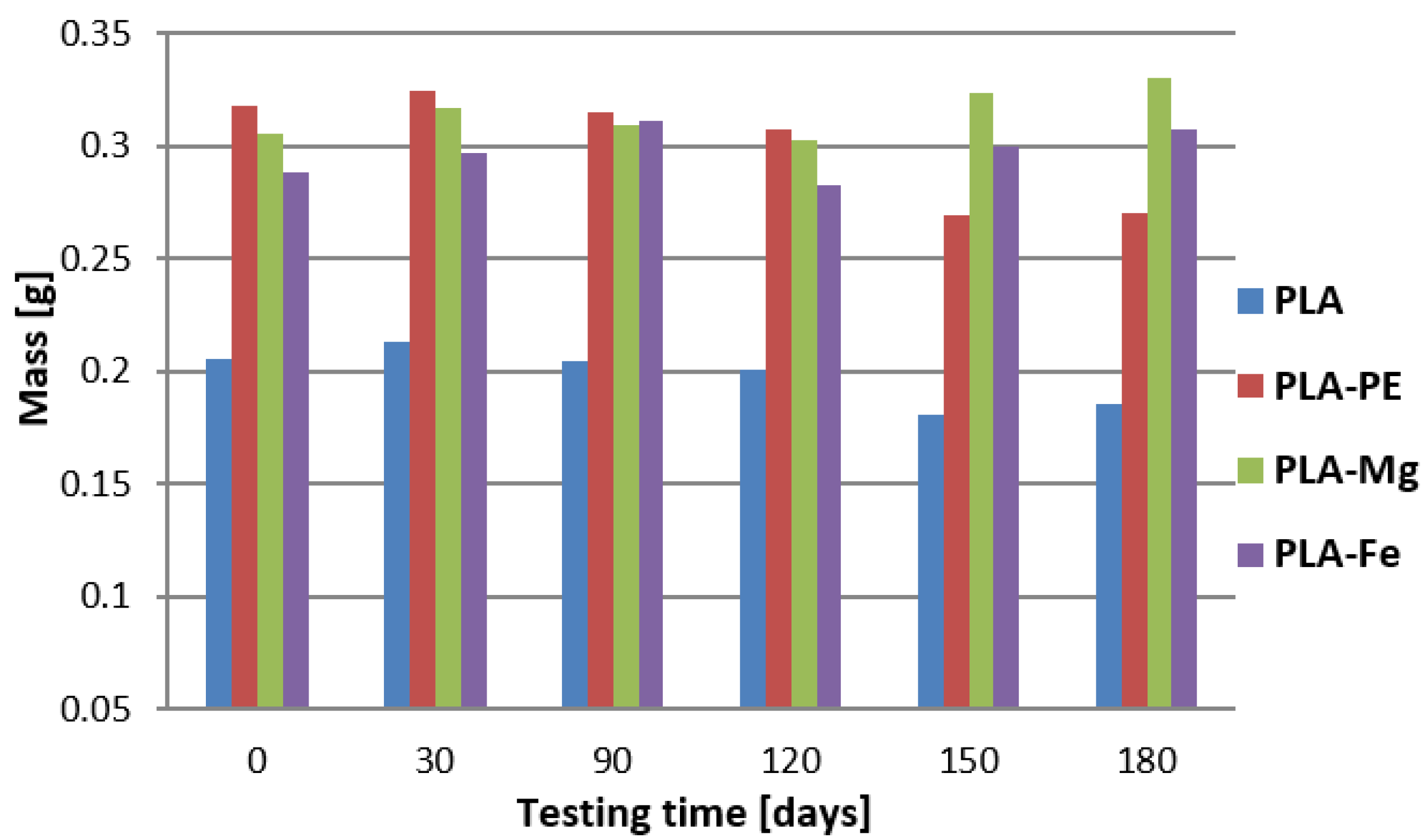

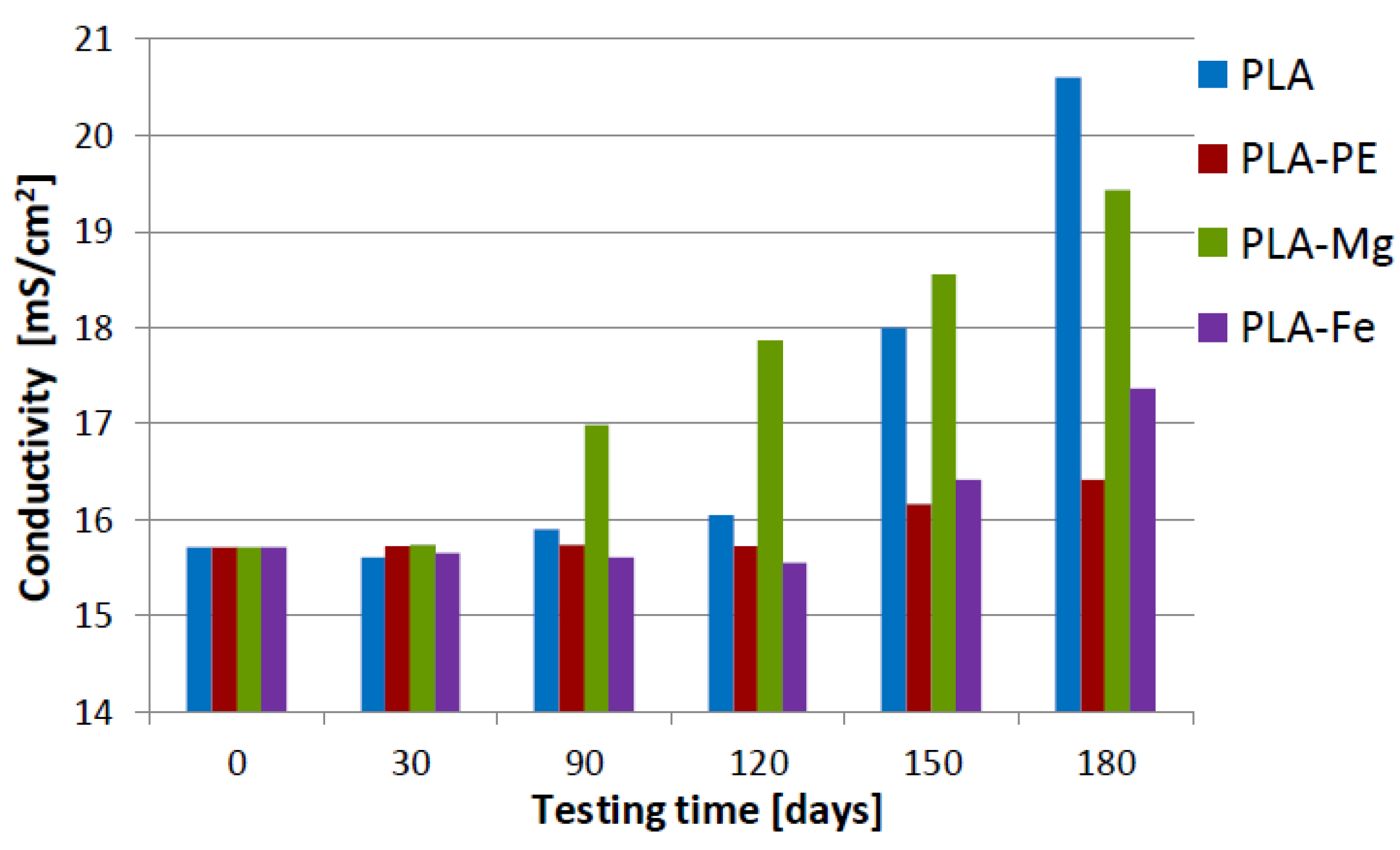
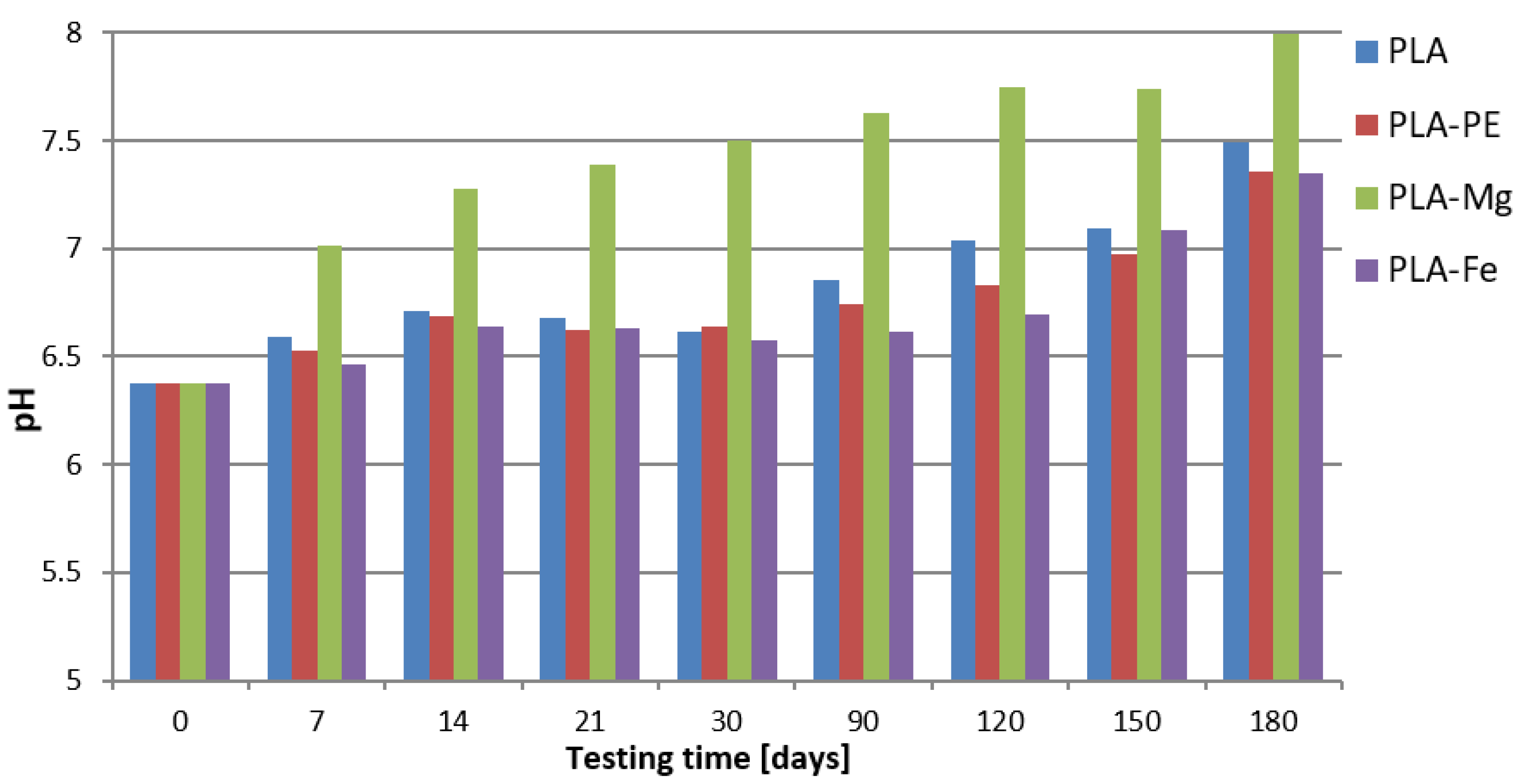
| Sample | σ [MPa] | ε [%] | YS0.2 [MPa] | E [MPa] | HS [°Sh] (CV) * |
|---|---|---|---|---|---|
| 100%PLA | 50.1 ± 1.55 | 2.00 ± 0.29 | 49.2 ± 0.29 | 3466 ± 84.4 | 66.8 ± 0.55 (0.82) |
| PLA-5%PE | 42.7 ± 1.25 | 2.05 ± 0.10 | 40.8 ± 1.64 | 3389 ± 121.1 | 68.4 ± 1.40 (2.02) |
| PLA-5%Mg | 49.1 ± 0.35 | 2.55 ± 0.76 | 47.6 ± 1.04 | 3573 ± 51.8 | 70.1 ± 1.35 (1.92) |
| PLA-5%Fe | 52.8 ± 2.75 | 2.15 ± 0.46 | 50.6 ± 2.39 | 3528 ± 76.2 | 71.7 ± 2.20 (3.04) |
| Sample | DSCheating | Tg (°C) | Tc (°C) | Tm (°C) | Xc (%) | T5% (°C) | T95% (°C) | Ea (kJ/mol) |
|---|---|---|---|---|---|---|---|---|
| PLA (0) | I | 57.4 | 116.6 | 148.8 | 13.35 | 306.5 | 353.7 | 73.3 |
| PLA (0) | II | 50.4 | 119.6 | 146.4 | 0.46 | - | - | - |
| PLA (180) | I | 71.1 | 98.1 | 151.8 | 30.15 | 286.1 | 347.8 | 131.4 |
| PLA (180) | II | 43.0 | 107.7 | 143.9 | 1.48 | - | - | - |
| PLA-PE (0) | I | 56.5 | 113.4 | 148.1 | 17.02 | 303.4 | 382.9 | 109.6 |
| PLA-PE (0) | II | 55.8 | 117.0 | 148.2 | 7.5 | - | - | - |
| PLA-PE (180) | I | 57.6 | 101.3 | 153.1 | 22.2 | 290.1 | 363.9 | 176.1 |
| PLA-PE (180) | II | 45.7 | 100.4 | 146.7 | 9.13 | - | - | - |
| PLA-Mg (0) | I | 58.9 | 113.7 | 148.3 | 7.06 | 269.3 | 300.9 | 80.5 |
| PLA-Mg (0) | II | 46.3 | 106.4 | 142.7 | 3.8 | - | - | - |
| PLA-Mg (180) | I | 70.5 | 91.0 | 147.7 | 20.64 | 240.5 | 279.2 | 139.8 |
| PLA-Mg (180) | II | 16.4 | 83.1 | 143.7 | 1.52 | - | - | - |
| PLA-Fe (0) | I | 57.2 | 112.9 | 146.9 | 12.37 | 285.7 | 309.9 | 88.1 |
| PLA-Fe (0) | II | 48.7 | 116.4 | 146.4 | 0.24 | - | - | - |
| PLA-Fe (180) | I | 53.3 | 97.6 | 151.7 | 20.07 | 272.8 | 310.3 | 171.4 |
| PLA-Fe (180) | II | 37.9 | 104.5 | 139.0 | 2.91 | - | - | - |
Publisher’s Note: MDPI stays neutral with regard to jurisdictional claims in published maps and institutional affiliations. |
© 2020 by the authors. Licensee MDPI, Basel, Switzerland. This article is an open access article distributed under the terms and conditions of the Creative Commons Attribution (CC BY) license (http://creativecommons.org/licenses/by/4.0/).
Share and Cite
Oksiuta, Z.; Jalbrzykowski, M.; Mystkowska, J.; Romanczuk, E.; Osiecki, T. Mechanical and Thermal Properties of Polylactide (PLA) Composites Modified with Mg, Fe, and Polyethylene (PE) Additives. Polymers 2020, 12, 2939. https://doi.org/10.3390/polym12122939
Oksiuta Z, Jalbrzykowski M, Mystkowska J, Romanczuk E, Osiecki T. Mechanical and Thermal Properties of Polylactide (PLA) Composites Modified with Mg, Fe, and Polyethylene (PE) Additives. Polymers. 2020; 12(12):2939. https://doi.org/10.3390/polym12122939
Chicago/Turabian StyleOksiuta, Zbigniew, Marek Jalbrzykowski, Joanna Mystkowska, Eliza Romanczuk, and Tomasz Osiecki. 2020. "Mechanical and Thermal Properties of Polylactide (PLA) Composites Modified with Mg, Fe, and Polyethylene (PE) Additives" Polymers 12, no. 12: 2939. https://doi.org/10.3390/polym12122939
APA StyleOksiuta, Z., Jalbrzykowski, M., Mystkowska, J., Romanczuk, E., & Osiecki, T. (2020). Mechanical and Thermal Properties of Polylactide (PLA) Composites Modified with Mg, Fe, and Polyethylene (PE) Additives. Polymers, 12(12), 2939. https://doi.org/10.3390/polym12122939









